Why The First Whole Foods Store Almost Failed
For those who've made the journey to eating healthier and organic foods, odds are that your favorite go-to grocer is none other than the famous Whole Foods Market, which has become one of the top healthiest grocery stores across the country, according to Women's Health. It's no secret that Whole Foods sells top-shelf products that range from an array of healthy chips to organic meats, and some of the best alcoholic beverage selections.
You might be surprised to know that this wasn't always the case for the grocery chain. In fact, Whole Foods didn't always sell products like meat, refined grains, or beer and wine when it was first opened in Austin, Texas under the name SaferWay Natural Foods in 1978 (via Whole Foods). Other products that were on SaferWay's forbidden list included coffee, poultry, seafood, and sugar! (via Business Insider). Thankfully, things have changed since then, as now Whole Foods sells some of the best items in these categories. But why the change?
The original idea for Whole Foods just wasn't selling
It's safe to say that things have definitely changed since Whole Foods Market founder and CEO John Mackey first launched his first venture into the grocery store arena before building the Whole Foods empire we've all come to know and love. But the Whole Foods products we now see stocked on shelves weren't what Mackey originally envisioned. To him, alcohol and sugar-based products weren't healthy enough. Mackey wanted to stick with items that were organic, free of artificial ingredients, like preservatives and flavorings. As a result, things weren't looking good for SaferWay and sales weren't exactly skyrocketing. Customers just weren't lining up to clean out the natural food store's shelves.
In an effort to save SaferWay, Mackey partnered with Craig Weller and Mark Skiles of Clarksville Natural Grocery to merge with their store and create the first-ever Whole Foods in 1980. After understanding the consumer mindset a lot more, Mackey agreed to put the "forbidden" products back on the store's shelves but keep a close eye on the list of ingredients as his goal remained the same — catering to healthy shoppers.
Rather than reinventing the wheel, Mackey saw the opportunity to better engage his customers and thus allowed us to live the Whole Foods shopping experience in more than 500 stores in North America and the U.K (via Whole Foods Market). The rest, as they say, is history.

